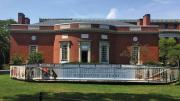In the summer of 2016, Primus was ascending Widener Library’s steps, in pursuit of some tome or other, where he met a visiting family disappointed that they could not enter the famous heap. Primus directed them around the corner to Houghton, where a vitrine of art for the Babar ABC book was then on display; happiness ensued, especially among the younger set.
Primus then inquired about the usefulness of putting up a sign at Widener’s entry, pointing around the corner to Houghton’s (often wonderful) displays, and was told that The Authorities had vetoed such a measure: not very gracious to well-intentioned tourists, he thought, and squandering potential goodwill.
So he was very much in favor of the July 24 installation of printed netting, advertising Houghton’s treasures and inviting passers-by inside, on the railing around the Pusey Library light court. Though some purists may find the very notion coarse, the banner is informative, welcoming, and useful—as the signage on light standards around Harvard Yard rarely is. (It is the Divinity School’s bicentennial—yes, and…? And where is the Peabody, for anyone interested in seeing the sesquicentennial exhibition on notice?)
This suggests a larger point. The Common Spaces project has encouraged visitors to lounge and lunch in the Old Yard. But the University makes no effort to tell them what buildings are what, or where to find the Harvard Art Museums (smartphones notwithstanding, how many confused visitors have asked the way from the T stop in the Square?), or what is on offer at the Collection of Historical Scientific Instruments (perfect for gadget-obsessed youngsters, some of them scientists-to-be), or where the glass flowers are (so to speak) rooted. This is an opportunity for the University to strut its stuff, with simple, clear, tasteful, uniform signage and directions. Harvard could do better—and with museums, exhibition experts, and a Graduate School of Design (GSD) at hand, it can do this well.
Architects anonymous. For all the building Harvard does, it hasn’t procured a whole lot of stunning, stimulating new architecture. Yes, Renzo Piano did the Fogg/Harvard Art Museums renovation and expansion; the interior staircase and handrail details are characteristic. But outside, the result feels committeed-up: witness the meticulously designed and crafted, but monochromatic and featureless, new façade along Prescott Street. It is premature to tell how the textured exterior of the Allston science and engineering complex, and the vast atrium within—all the fruits of Behnisch Architekten—will turn out (see images in John Harvard’s Journal, September-October, pages 14-15). But even if successful, it is far from any pedestrian-frequented area.
So it was surprising to learn that the renovation of a frame building on Sumner Road into “HouseZero” (the energy-yielding, non-emitting new quarters for the GSD’s Center for Green Buildings and Cities) was designed by Snøhetta: about as high-profile, international, and modernist a crew as one can find. The interior schematics appear to live up to the firm’s Scandinavia vibe (see renderings at harvardmag.com/housezero-17). Because the house is in a Cambridge historic district, however, the 1924 exterior remains unchanged; the pyrotechnics within will not carry over to the experience of passersby, alas.
Finally, Primus understands that another jazzy firm, Barkow Leibinger, based in Berlin and New York (albeit with acceptably Cantabrigian roots: Frank Barkow, M.Arch. ’90, and Regine Leibinger, M.Arch. ’91), is on assignment for Harvard. No details yet, but their portfolio appears happily free of red brick. Hope springs eternal.







